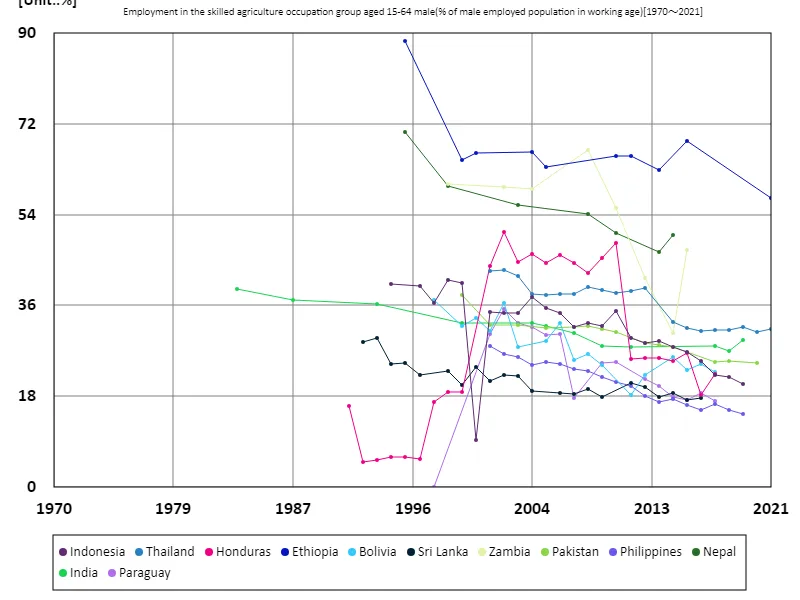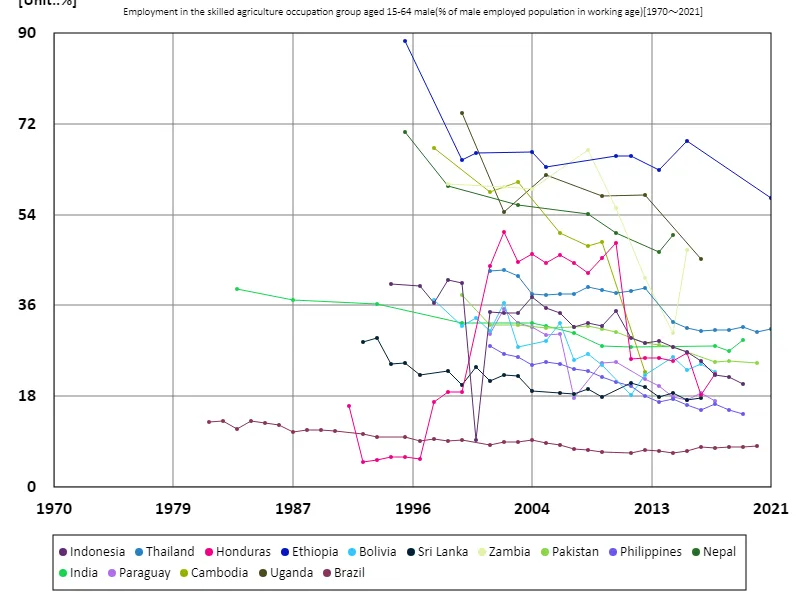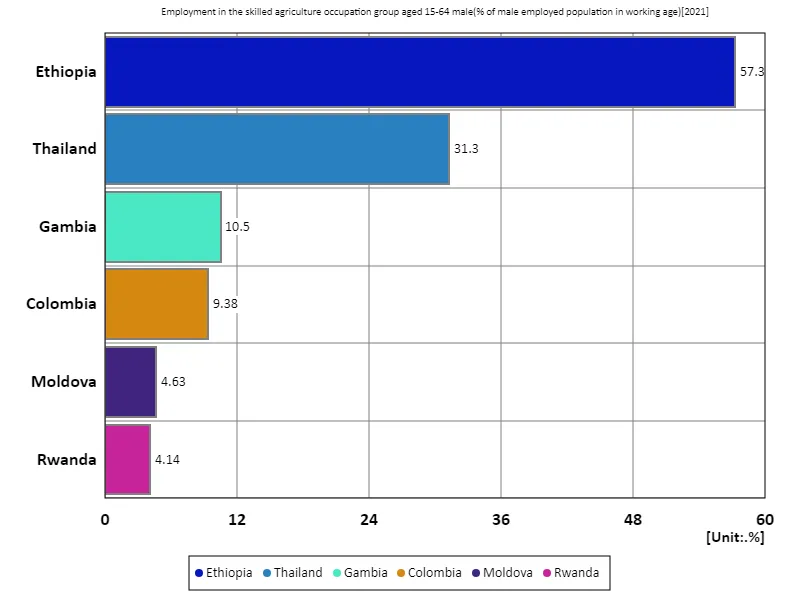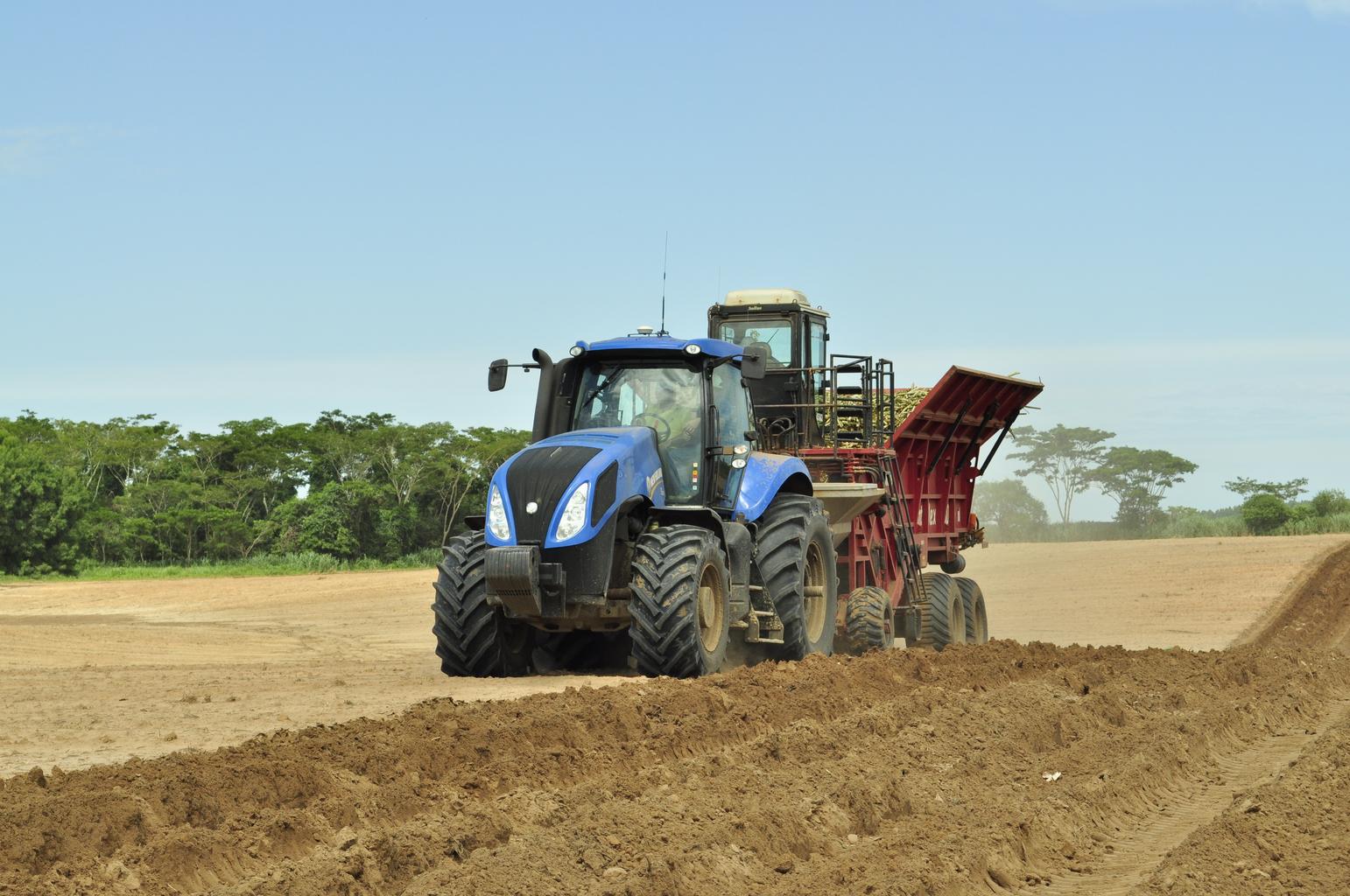- Abstract
- Employment rate in skilled agricultural sector for men aged 15-64 (percentage of working-age males in the workforce)
- Employment rate in the skilled agricultural sector for men aged 15-64 (percentage of working-age males in the labour force) (Worldwide)
- Employment rate in skilled agricultural sector for men aged 15-64 (percentage of working-age males in the labour force) (World, latest year)
- Reference
Abstract
The employment rate in the skilled agricultural sector is an important indicator that reflects a country’s dependency on agriculture and its stage of economic development. Data for 2021 shows that Ethiopia relies on the skilled agricultural sector for 57.3% of its male workforce aged 15-64, indicating that the country’s economy is still highly dependent on agriculture. In a country like Ethiopia, agriculture is the primary source of livelihood and many people are employed in this sector. On the other hand, in developed and highly industrialized countries, employment in the agricultural sector is low, with manufacturing and services being the main sources of employment. Countries with a high rate of employment in the agricultural sector are required to promote policies to improve agricultural productivity and modernize their agriculture. In particular, in countries such as Ethiopia that are highly dependent on agriculture, innovation in agricultural technology and improvement of education are key to economic diversification and sustainable growth.
Employment rate in skilled agricultural sector for men aged 15-64 (percentage of working-age males in the workforce)
Looking at data from 1983 to 2021, the employment rate in the skilled agricultural sector is an important indicator of a country’s stage of economic development and its dependence on agriculture. In particular, Ethiopia’s dependence on agriculture was extremely high at the time, as 88.4% of men aged 15-64 were employed in the skilled agricultural sector in 1995. This high level of dependence indicates that Ethiopia’s economy was primarily agricultural. However, subsequent data shows that in 2021, employment in the skilled agricultural sector fell to 64.8%. This change suggests that Ethiopia is shifting away from agriculture. This trend is driven by factors such as improved agricultural efficiency, technological innovation and increasing urbanization. Policies to increase agricultural productivity and diversify the economy are helping to reduce reliance on the agriculture sector. The spread of education and changes in the labor market are also contributing factors. The challenge for Ethiopia going forward will be how to overcome these changes and achieve sustainable economic growth.


The maximum is 88.4%[1995] of Ethiopia, and the current value is about 64.8%
Employment rate in the skilled agricultural sector for men aged 15-64 (percentage of working-age males in the labour force) (Worldwide)
Looking at data from 1981 to 2021, the employment rate in the skilled agricultural sector is an important indicator that reflects a country’s economic structure and stage of development. In particular, in Ethiopia, 88.4% of men aged 15-64 were employed in the skilled agricultural sector in 1995, indicating a high dependency on agriculture at that time. This high employment rate reflects Ethiopia’s economy’s primary reliance on agriculture and represents a time when agriculture was the primary source of livelihood. However, 2021 data shows that employment in Ethiopia’s skilled agricultural sector has fallen to 64.8%. The decline reflects Ethiopia’s efforts to diversify its economy away from agriculture and towards manufacturing and services. Increased efficiency in agriculture, technological innovation and increasing urbanization are driving this change, which is reducing agriculture’s share of the labour market. The spread of education and the development of new industries also have an impact. Economic diversification and agricultural modernization remain key issues for Ethiopia to achieve sustainable growth.


The maximum is 88.4%[1995] of Ethiopia, and the current value is about 64.8%
Employment rate in skilled agricultural sector for men aged 15-64 (percentage of working-age males in the labour force) (World, latest year)
According to 2021 data, Ethiopia recorded the highest employment rate in the skilled agricultural sector for men aged 15-64 at 57.3%. In comparison, the overall average was 19.5%, with 117% of the total indicating that data from each country was being duplicated. Ethiopia’s high employment rate reflects the country’s continued dependence on agriculture, with many men working in the field. On the other hand, the average value of 19.5% indicates that employment in the agricultural sector is relatively low in many countries. This indicates that in countries where non-agricultural industries are developed, manufacturing and services are the main sources of employment. Overall, as economies develop, employment in the agriculture sector declines and is increasingly dominated by other industries. In countries like Ethiopia that are highly dependent on agriculture, while there is a need to modernize agriculture and improve productivity, developing industries other than agriculture is also an important issue.


The maximum is 57.3% of Ethiopia, the average is 19.5%, and the total is 117%



Comments